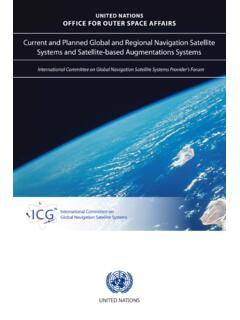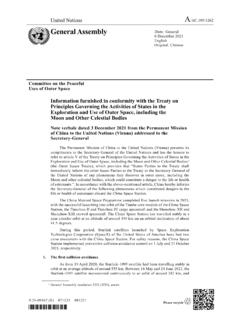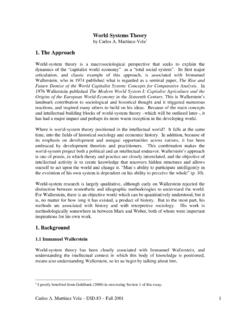Transcription of World Geodetic System 1984 - UNOOSA
1 World Geodetic System 1984. Responsible Organization: National Geospatial-Intelligence Agency Abbreviated Frame Name: WGS 84. Associated TRS: WGS 84. Coverage of Frame: global Type of Frame: 3-Dimensional Last Version: WGS 84 (G1674). Reference Epoch: Brief Description: WGS 84 is an Earth-centered, Earth-fixed terrestrial reference System and Geodetic datum. WGS 84 is based on a consistent set of constants and model parameters that describe the Earth's size, shape, and gravity and geomagnetic fields. WGS 84 is the standard Department of Defense definition of a global reference System for geospatial information and is the reference System for the global positioning System (GPS). It is compatible with the International Terrestrial Reference System (ITRS). Definition of Frame Origin: Earth's center of mass being defined for the whole Earth including oceans and atmosphere Axes: o Z-Axis = The direction of the IERS Reference Pole (IRP).
2 This direction corresponds to the direction of the BIH Conventional Terrestrial Pole (CTP). (epoch ) with an uncertainty of . o X-Axis = Intersection of the IERS Reference Meridian (IRM) and the plane passing through the origin and normal to the Z-axis. The IRM is coincident with the BIH Zero Meridian (epoch ) with an uncertainty of . o Y-Axis = Completes a right-handed, Earth-Centered Earth-Fixed (ECEF). orthogonal coordinate System Scale: Its scale is that of the local Earth frame, in the meaning of a relativistic theory of gravitation. Aligns with ITRS. Orientation: Given by the Bureau International de l'Heure (BIH) orientation of Time Evolution: Its time evolution in orientation will create no residual global rotation with regards to the crust Coordinate System : Cartesian Coordinates (X, Y, Z). WGS 84 (G1674) follows the criteria outlined in the International Earth Rotation Service (IERS) Technical Note 21.
3 The WGS 84. Coordinate System origin also serves as the geometric center of the WGS 84 Ellipsoid and the Z- axis serves as the rotational axis of this ellipsoid of revolution. WGS 84 Geodetic coordinates are generated by using its reference ellipsoid. Defining Parameters: WGS 84 identifies four defining parameters. These are the semi-major axis of the WGS 84 ellipsoid, the flattening factor of the Earth, the nominal mean angular velocity of the Earth, and the geocentric gravitational constant as specified below. Parameter Notation Value Semi-major Axis a meters Flattening Factor of the Earth 1/f Nominal Mean Angular Velocity of the 7292115 x 10-11. Earth radians/second Geocentric Gravitational Constant (Mass GM** x 1014. of Earth's Atmosphere Included) meter3/second2. 14 3 2. **The value of GM for GPS users is m /sec as specified in the references below.
4 References: NIMA Technical Report Department of Defense, World Geodetic System 1984, Its Definition and Relationships with Local Geodetic Systems . Addendum to NIMA TR : Implementation of the World Geodetic System 1984. (WGS 84) Reference Frame G1150. NAVSTAR global positioning System Interface Specification (IS-GPS-200), NAVSTAR. GPS Space Segment / Navigation User Interface. Relationship with other reference systems: WGS 84 (G1674) is aligned to ITRF2008 with the same epoch of The purpose of this alignment is to ensure scientific integrity and follow best practices. The ITRF incorporates multiple methods to realize the reference System such as satellite laser ranging and very-long- baseline interferometry that NGA does not include. Adjusting WGS 84 to ITRF allows the reference frame to take advantage of those methods without directly incorporating them into the coordinate determination software.
5 WGS 84 (G1674) adopted the values of NGA stations coordinates in the ITRF2008 reference frame with the exception of its stations located in Bahrain and Korea. Computations were performed to align the remaining WGS 84 reference stations to this network. For WGS 84. (G1674), all WGS 84 reference stations adopted ITRF2008 velocities of the station or nearby sites. The estimated accuracy of WGS 84 (G1674) is better than one centimeter overall for each of the reference frame station coordinates. The 7-parameter transformation from WGS 84. (G1674) to ITRF2008 is zero in all components. This is by design since WGS 84 (G1674). adopted ITRF2008 coordinates and velocities in common stations between the two reference frames in all but two exceptions. This process ensures that WGS 84 is aligned to ITRF2008 to better than one centimeter at initial WGS 84 (G1674) release.
6 Transformation Parameters The parameters are defined from the listed reference frame to WGS 84 (G1674) at epoch Reference Frame Tx Ty Tz D Rx Ry Rz (reference frame epoch) (mm) (mm) (mm) (ppb) (mas) (mas) (mas). (sigma) (sigma) (sigma) (sigma) (sigma) (sigma) (sigma). WGS 84 (G1150)# ( ) ITRF2008* 0 0 0 0 0 0 0. ( ). # The sign convention for the rotations Rx, Ry, and Rz is what NGA uses in its orbit comparison programs and is opposite to that of IERS Technical Note No. 36, Equation and following. *Zero by construction. Notes: The GPS reference System is WGS 84. GPS users directly receive WGS 84 coordinates from a GPS receiver if no changes to the reference frame are selected or made. The software that generates GPS Broadcast orbits is updated at the beginning of each calendar year with an epoch at the half-year mark to account for plate tectonic motion.
7 This method results in a yearly step-wise adjustment of WGS 84 coordinates delivered through GPS broadcast orbits. For example, GPS broadcast orbits at the time of this writing have an epoch of Reference frame station locations are updated for any sudden displacement such as an earthquake. The DoD Precise GPS orbits generated by NGA incorporate plate motion by using the WGS 84 reference stations propagated forward using reference station velocities. Future Plans: NGA plans to conduct a WGS 84 reference frame network adjustment in early 2013 to incorporate IERS Conventions 2010 Technical Note 36 (TN 36). Note that WGS 84 will retain its four defining parameters of which some do not comply with TN 36. When completed, the newest realization of WGS 84 will be published, and NGA (formerly NIMA) Technical Report will be updated.










